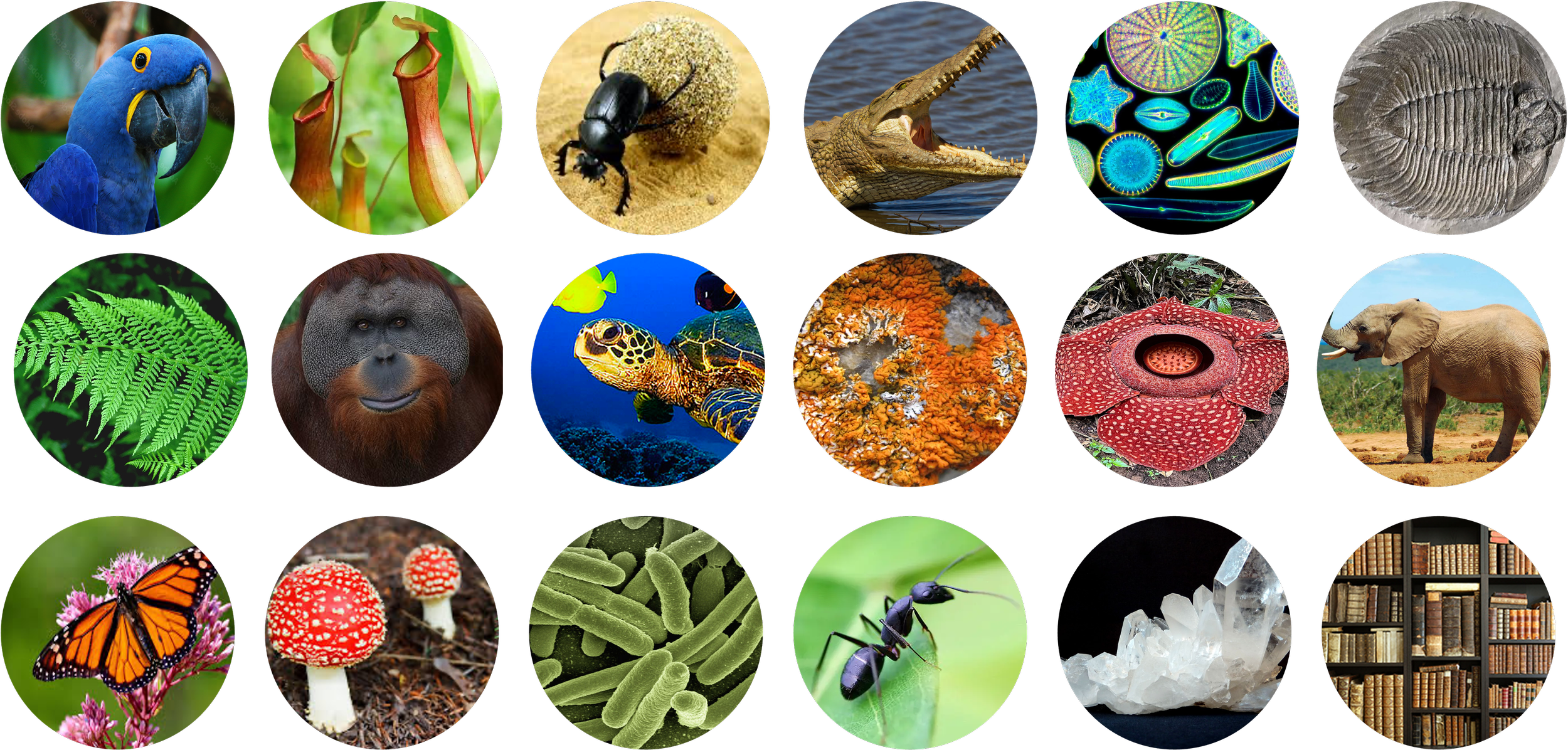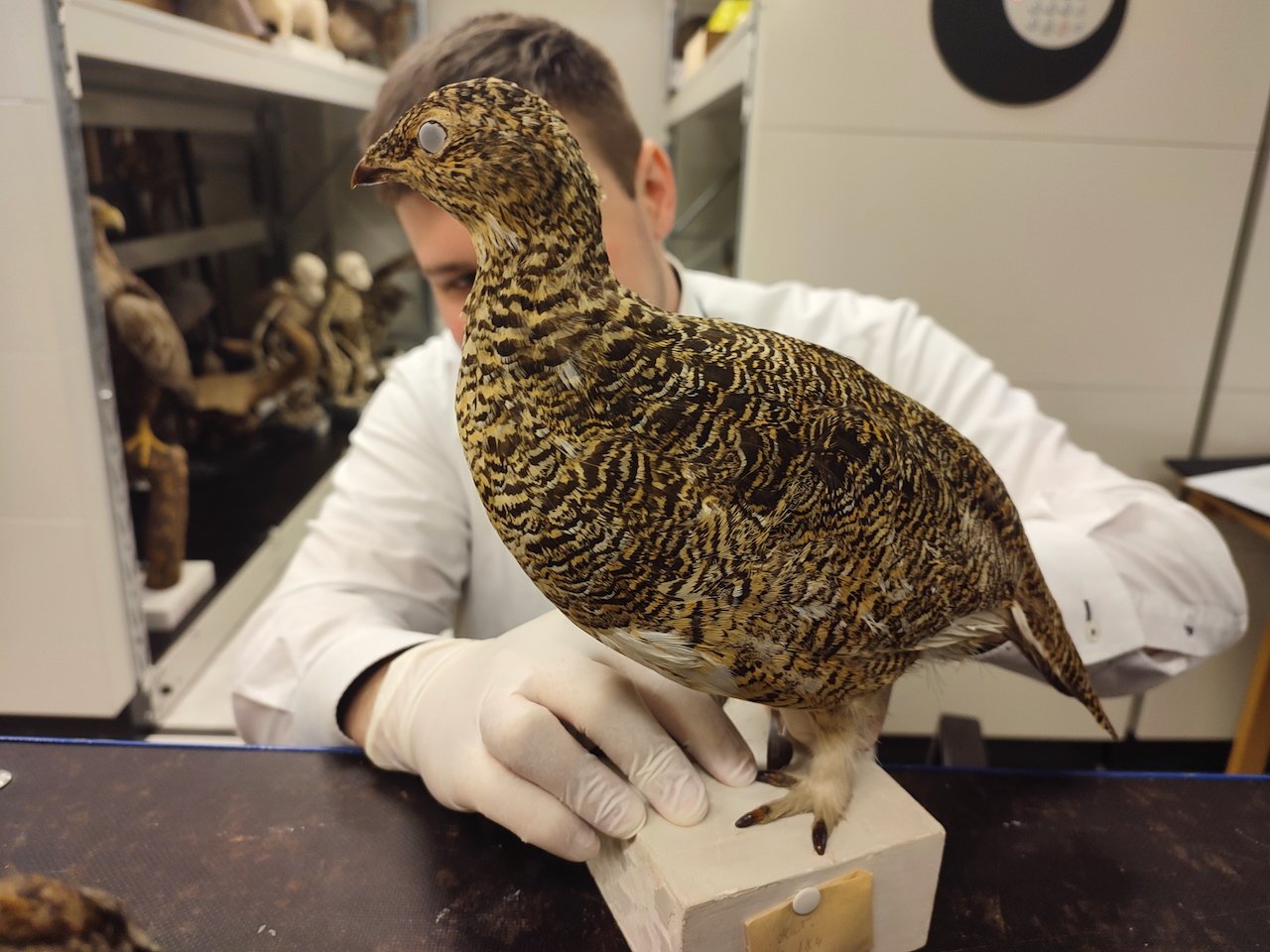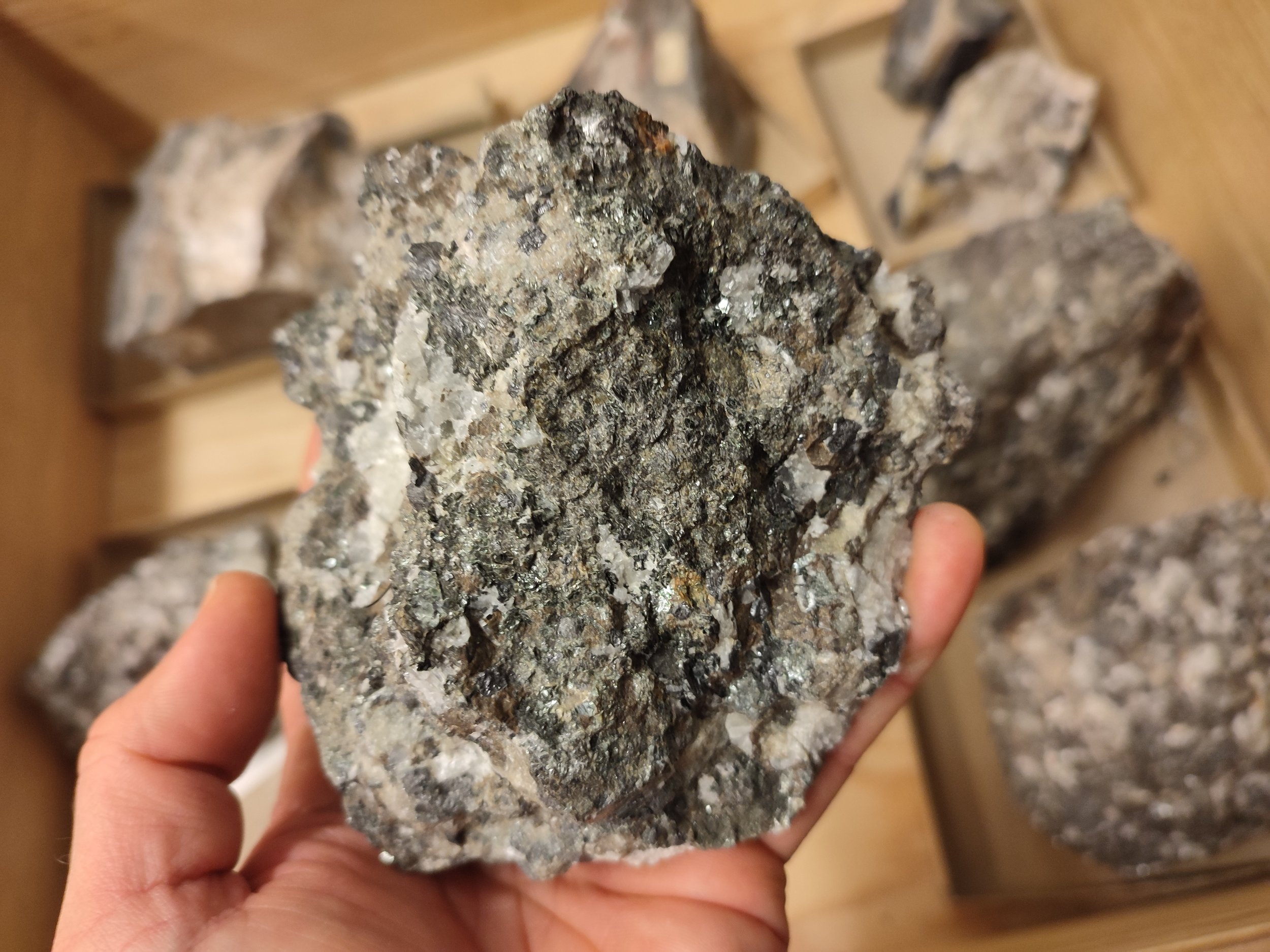Funding our projects have local and global impact on science and society
We need experts to improve our collections, describe new species, and ensure biodiversity data are findable, accessible, interoperable, and reuseable for generations to come. Digitising collections provides data that advances drug discovery, mineral exploraion, agricultural development, biodiversity conservation and combating economically important invasive species.
Your generous support for Biodiversity Beyond Linnaeus helps us in several key ways: it allows us to hire expert staff at the Evolutionsmuseet to carry out high-priority projects, attract top taxonomists through a visiting fund, and support expeditions. Together, these efforts help us continue our vital work to protect biodiversity for future generations.

Fund our zoology projects!
-

Support a vertebrate curator (BBLZOO1)
Funding a Vertebrate Zoology Curator at Evolutionmuseet will support research, teaching, and the care of the museum’s vertebrate collections. The position will help digitize and maintain approximately 20,000+ valuable specimens, which are regularly used by researchers, teachers and students. These are not only skeletons and stuffed animals, but also, eggs, nests and a unique historical collection of dry organs from the early XXth century.
-

Marine invertebrate expert (BBLZOO2)
We have a very large collection of marine invertebrates in desperate need of taxonomic update and digitization. Specifically, the shell collections will benefit from the expertise of a mollusc specialist. Your support will notably help maintain 1,251 shells from the Linnaean collection along with more than 200,000 marine invertebrate specimens, including corals, jellyfishs, anemones, seastars, clams and snails. Only 5% are currently registered and accessible online.
-

Medical entomology curator (BBLZOO3)
To honor the legacy of Professor Thomas Jaenson, a leading expert in medical entomology, we are seeking funding for a curator to care for his invaluable collections of disease vectors. These include over 10,000 ticks and more than 10,000 mosquitoes collected during his decades of research on tick-borne diseases in Sweden and malaria-transmitting mosquitoes in Africa. These unique specimens and archives contain important data which are critical to understanding how vector-borne diseases are influenced by climate change, wildlife, and human activity, both nationally and globally. A dedicated curator will ensure these collections remain accessible for future research and public health preparedness, supporting Sweden’s capacity to monitor, prevent, and respond to emerging infectious threats.
-

Insect biodiversity curator (BBLZOO4)
Insects are the little things that run the world, delivering vital ecosystem services from pollination to decomposition and carbon sequestration. The entomological collection at Evolutionsmuseet comprises approximately 1.5 million specimens from around the globe, with particular strength in Nordic material. Major holdings include 138,000 Hemiptera (true bugs), 276,000 Coleoptera (beetles), 360,000 Hymenoptera (ants, bees, and wasps), 157,500 Lepidoptera (butterflies and moths), and 324,000 Diptera (true flies), stored across thousands of drawers. Much of this material requires systematic organising and updating according to standard European labeling systems. We are seeking funding for a curator to lead this essential work, including databasing and digitisation, ensuring that biodiversity data are findable, accessible, interoperable, and reusable (FAIR) by both science and society.
-

Entomology Curatorial Assistant (BBLZOO5)
To support the long-term stewardship of our entomological collections, we are also seeking support for an Entomology Curatorial Assistant. One of our key objectives is ensuring the collection continues to be a centre for research and information about Nordic and world insects. Training curators is essential to pass on knowledge to future generations, ensuring continued stewardship of important insect biodiversity, and ensuring that specimens are available to science and society. The assistant will learn specialist methods and techniques from both the Insect Biodiversity Curator and the Medical Entomology Curator, gaining valuable skills across a wide range of insect groups and collection types. This role will provide hands-on training in collection management, taxonomy, and digitisation, contributing to the effective care of these important collections.
-

Zoology conservator/technician (BBLZOO6)
It is our responsibility to pass specimens on to the future generations. This requires expert knowledge of specimen treatment, labelling, preservation, repair and care. Help us continue our legacy and pass on the specimens in good condtion for the coming centuries. This person will have the highly sensitive task of restoring the Linnaean specimens, some of which are in poor state, after more than 250 years in our collections.

Fund our botany projects!
-

Curator of lichens (BBLBOT1)
Evolutionsmuseet is one of the top three most important lichen collections in the world. We continuously describe new species using new techniques, such as molecular tools. Your support will help update our global understanding of lichen biodiversity and species distributions.
-

Bryophytes & algae collections (BBLBOT2)
The bryophytes and algae collections have had too little attention for the past five decades. With 250,000 mosses and 80,000 alage specimens in need of databasing, we need your support to fund an expert curator.
-

Support a Nordic vascular plant curator (BBLBOT3)
Our herbarium contains 1.9 million vascular plants from the Nordics and the rest of the world. With urgent need of more biodiversity data, this project will support the ongoing mapping of species distribution through databasing and digitisation of our collections.
-

Fund an assistant curator (BBLBOT4)
Funding an Assistant Curator for Botany at Evolutionmuseet will support the care and documentation of the museum’s plant collections. This role will assist with research, collection management, and research related to botanical diversity. The assistant curator will help ensure that plant specimens are preserved and accessible for study.

Fund our paleontology projects!
-

A prehistoric Serengeti (BBLPAL1)
In our magazines we have an enormous collection of now extinct species of elephants, rhinoceroses, gazelles, giraffes, predators, ostriches and so on, excavated in China in the 1920’s through the Sino-Swedish collaboration. These beasts roamed a vast area of Eurasia ~20 – to 1 million years ago, in an environment resembling the Serengeti today. This material is the heart of our fossil vertebrate collection and it is extensively researched foremost by Chinese colleagues. But we need to bring the collection up to date with our modern catalogue system and need a specialist vertebrate curator to do the job.
-

A Swedish dinosaur! (BBLPAL2)
We have the only known Swedish dinosaur! It is a large predatory beast, about 200 million years old, and was dug out in Skåne by a team of Uppsala palaeontologists. It is yet to be named. However, it is not an isolated find, but part of a unique ongoing project to document the entire ecosystem where it lived. More than 4000 specimens of fossil plants and animals have been collected. The curatorial aspects of this project are demanding and therefore we need a curatorial assistant to work with the lead researcher to organize, catalogue, conserved and (to some extend) digitized the material.
-

Shells galore and more! (BBLPAL3)
During the last five years the museum has acquired the largest private fossil collection in Sweden, a staggering amount of mostly Swedish fossils from the older fossil bearing strata, amassed through almost 40 years by private collector Jan Johansson in Närke. The size of the collection is remarkable, with several thousands of specimens, but more importantly the fossils are carefully collected and labelled. Many are from now inaccessible sites. Its value lies in the scientific and educational potential that such a collection present. But to make it available, organized and catalogued we need curatorial assistant.
-

Conservation trainee (BBLPAL4)
Collections are in constant need of maintenance. As objects, they are endangered by the deteriorating effects of time, poor inhouse climate conditions, light, handling and so on. We are fortunate to have a conservator and a conservation lab, but the work load is demanding and the many tasks challenging. Ideally, we would therefore like to have an apprentice that can help with the many tasks and at the same time be groomed for a future in our conservation unit. This will ensure continuity and quality in our work with preserving the collections.
-

A digitized dinosaur (BBLPAL5)
Tanius sinensis is a ~70 million year old dinosaur from China, brought back to Uppsala 1923 through the Sino-Swedish collaboration. It is one of two Chinese dinosaur that were the first in the world to be scientifically described. But Tanius is extremely fragile and cannot be exhibited or handled much by scientists. With the help of an assistant curator, we aim to digitize Tanius. A 3D-scan will give us a detailed digital model and reproduction of the skeleton that can be used by researchers and we can mount and exhibit this magnificent Uppsala dinosaur. It also spares the real bones from handling and preserve it for posterity.

Fund our mineralogy project!
-

Support a junior mineralogy curator (BBLMIN1)
Our mineral collection contains a wealth of data both about each object and about the people who have collected and worked with the collections over the past 300 years. It is important that both written and orally transmitted information is not lost. Support a junior museum curator who can groomed into be the future bearer of knowledge about our mineral collections

Fund our library & archives projects!
-

Natural History Librarian (BBLLA1)
A pressing need exists for the funding of a dedicated natural history librarian. With over 40,000 archival items spanning zoology, botany, paleontology, and mineralogy, these remarkable collections remain largely untapped due to a lack of specialized oversight. A librarian with the expertise to standardize and organize this material—and to create a searchable database—would transform access to the archives, giving curators the tools they need to better understand and share the collections they care for. Your support can help unlock the full potential of these resources, opening new pathways for research, education, and public engagement across the natural sciences.
-

Digitizing Thunberg Archive (BBLLA2)
Among the most historically significant materials in the museum’s care are 30 handwritten catalogues by Carl Peter Thunberg, created between 1785 and 1828 to document the zoological collection. A prominent botanist and zoologist, Thunberg was a key figure in the global expansion of natural history during the late 18th century and a direct disciple of Carl Linnaeus—though often overshadowed by his famous mentor. These catalogues are not only vital reference tools for today’s curators, but also a rare and invaluable primary source for historians and scientists studying the development of biodiversity knowledge. Digitizing this archive is essential not only for preservation, but to ensure that curators and researchers can actively access, study, and meaningfully engage with these materials as a cornerstone of the museum’s scientific and historical legacy.
-

The Kullenberg Excursions (BBLLA3)
The field notes of Bertil Kullenberg, spanning over three decades of biological excursions, is a valuable yet completely unutilized scientific resource. Rich in occurrence data—particularly on insects and birds—these notes offer a detailed record of Uppsala’s biodiversity from a past era. Digitizing this material is crucial for making the currently hidden data, accessible to a wider research community. Once digitized, these data can be mobilized and utilized in current predictive modeling research that assesses biodiversity change and loss over time. With your support, this project will bridge historical observations with cutting-edge science, creating new opportunities for understanding and protecting biodiversity.
-

The Sino-Swedish archives (BBLLA4)
The Sino-Swedish collaboration 1918-1927 was arguably the most significant scientific collaboration in the history of Swedish research. We look for a research scientist that can work with us on an interdisciplinary project that will map and digitize historical archival data in Sweden and China collected and produced during Sino-Swedish natural history expeditions in China. The aim is to understand the significance of the collaboration and evaluate the state-of-the-art of the palaeontological theories at the time when the material was collected, to be compared to present day theories and procedures within science. The Museum of Evolution archives are one important piece of the puzzle, but a broad scope will hugely benefit research at natural science and cultural heritage institutions beyond the Swedish scientific community.

Funding for visiting experts
-
Visiting Experts in Botany (BBLVEB)
Support the engagement of leading botanical experts for short-term visits focused on expert curation and taxonomic knowledge. This funding enhances our collections, strengthens research accuracy, and ensures the highest standards in plant identification and classification through hands-on collaboration and knowledge exchange.
-
Visiting Experts in Zoology (BBLVEZ)
Support short-term visits by leading zoologists to provide specialized taxonomic expertise and curatorial insight. These visits directly benefit our zoological collections through improved identification, refined classification, and enhanced curation practices, ensuring they remain scientifically robust.
-
Visiting Experts in Paleontology (BBLVEP)
Support short-term visits of paleontology experts to contribute specific taxonomic knowledge and curatorial support. These visits help improve specimen identification, update classifications, and enhance the care and documentation of our paleontological collections.

Funding for expeditions
-
Botanical expeditions (BBLEXB)
Plants are the foundation of life on Earth, and yet, so many species remain undocumented or under threat. Your support helps fund expeditions that collect, study, and preserve botanical specimens from around the globe, ensuring they are represented in our contemporary collections. With your donation, we can deepen our understanding of plant life, support conservation efforts, and inspire future generations through the power of botanical knowledge.
-
Zoological expeditions (BBLEXZ)
Whether teaching tropical ecology in threatened rainforests or setting out by boat to collect rare marine sponges, our zoologists are focused on understanding how life adapts in a rapidly changing world. The specimens we collect contribute to the collections at Evolutionmuseet, helping to expand our knowledge of biodiversity and its evolution. With your support, we can continue these important expeditions, gather specimens for future study, and share what we learn with the next generation of scientists and educators. Help us continue to document species, support field-based learning, and ensure that this knowledge is passed on.
-
Paleontological expeditions (BBLEXP)
Fossils hold the keys to Earth's ancient history, offering insight into evolution, extinction, and climate change. With your support, we can fund paleontological expeditions that uncover and preserve these irreplaceable records of past environments. Donations help us expand our fossil collections, support fieldwork, and inspire awe and learning through the stories these specimens tell.

